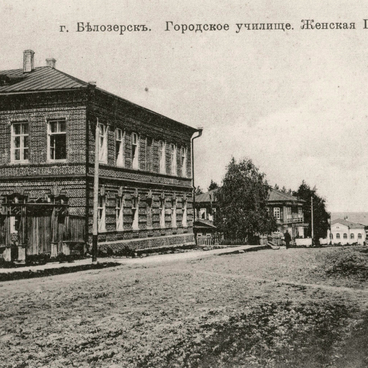The engraving is done on a printed sheet with white margins. The monastery ensemble is located in the background. Here you can see the powerful walls constructed by the efforts of the prior Theothanus, a series of churches built in different centuries, a narrow bridge connecting the island and the land. The foreground is taken up by smooth water and scattered trees. On the right side of the bank, a chapel can be seen in the middle of the bush, and on the shore, a wanderer with a staff is watching the place. In the background there is a beach with tall trees, houses, a temple.
The restoration of the engraving was carried out in 2010 in the Vologda branch of the Grabar Art Conservation Center by the artist-restorer Olga Rebrova. The restorers confirmed the dating of the work -- 1823. The authors' names were also revealed: the drawing from nature was made by engineer-major Kaulin (Kauling), and engraved by Andrei UkhtOmsky. It was also revealed that the engraving was given to the prior of the monastery Theothanus (Sokolov). The dedicatory inscription reads: ‘View of the Kirilllo-Novosersky Monastery / To the Prior of the afore-mentioned Archimandrite Theophanus / from Belozersk citizens, 1823’.
The Novoezersky Monastery was founded by Reverend Kirill. His hagiography tells that twice the Virgin has appeared to him and has directed him to go to the White Lake. In 1517 Kirill arrived in the Belozersk lands and, having asked permission from local peasants, settled on the Krasnyi island. Soon Kirill was joined by like-minded people. As late as 1518, the first settlers built two small wooden temples: in the name of the Resurrection of Christ and the icon of Our Lady of Smolensk. When the founder was alive, the monastery acquired its own land and peasants. Grand Duke Vasily Ivanovich granted the monastery the villages of Kobylino and Shidnema, that stood on the nearby river bank. Kirill Novozersky lived in his abode for another 20 years and died on February 4, 1537.
In 1584 Ivan the Terrible gave the monastery 1000 rubles, plenty of churchware and 11 villages along the shores of Lake Novo. In the first quarter of the 17th century, the Monastery was exempted from paying all kinds of duties and received possession of three lakes in addition to the land.
In different years, representatives of the imperial Romanov family visited the monastery. The monastery was closed in 1919, all objects of artistic and historical value and utensils were transferred to the Cherepovets Museum.
The restoration of the engraving was carried out in 2010 in the Vologda branch of the Grabar Art Conservation Center by the artist-restorer Olga Rebrova. The restorers confirmed the dating of the work -- 1823. The authors' names were also revealed: the drawing from nature was made by engineer-major Kaulin (Kauling), and engraved by Andrei UkhtOmsky. It was also revealed that the engraving was given to the prior of the monastery Theothanus (Sokolov). The dedicatory inscription reads: ‘View of the Kirilllo-Novosersky Monastery / To the Prior of the afore-mentioned Archimandrite Theophanus / from Belozersk citizens, 1823’.
The Novoezersky Monastery was founded by Reverend Kirill. His hagiography tells that twice the Virgin has appeared to him and has directed him to go to the White Lake. In 1517 Kirill arrived in the Belozersk lands and, having asked permission from local peasants, settled on the Krasnyi island. Soon Kirill was joined by like-minded people. As late as 1518, the first settlers built two small wooden temples: in the name of the Resurrection of Christ and the icon of Our Lady of Smolensk. When the founder was alive, the monastery acquired its own land and peasants. Grand Duke Vasily Ivanovich granted the monastery the villages of Kobylino and Shidnema, that stood on the nearby river bank. Kirill Novozersky lived in his abode for another 20 years and died on February 4, 1537.
In 1584 Ivan the Terrible gave the monastery 1000 rubles, plenty of churchware and 11 villages along the shores of Lake Novo. In the first quarter of the 17th century, the Monastery was exempted from paying all kinds of duties and received possession of three lakes in addition to the land.
In different years, representatives of the imperial Romanov family visited the monastery. The monastery was closed in 1919, all objects of artistic and historical value and utensils were transferred to the Cherepovets Museum.



